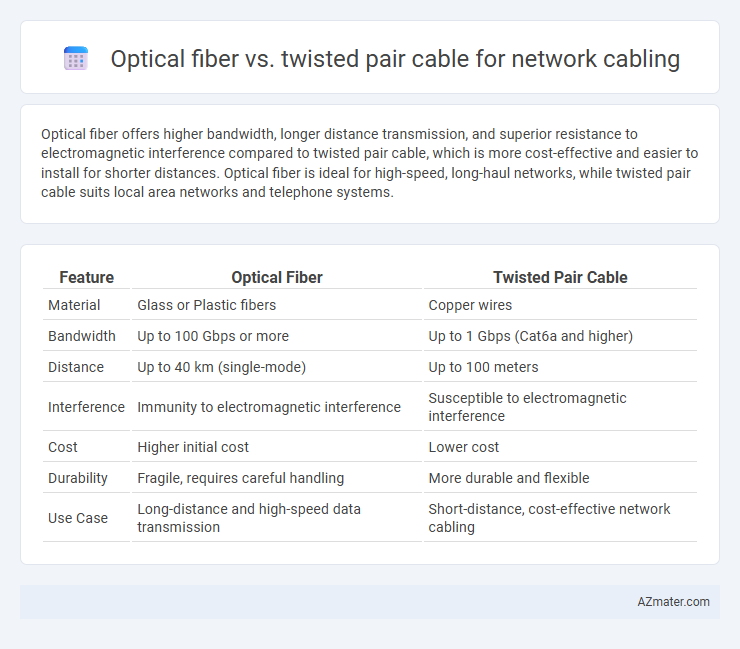Optical fiber offers higher bandwidth, longer distance transmission, and superior resistance to electromagnetic interference compared to twisted pair cable, which is more cost-effective and easier to install for shorter distances. Optical fiber is ideal for high-speed, long-haul networks, while twisted pair cable suits local area networks and telephone systems.
Table of Comparison
| Feature | Optical Fiber | Twisted Pair Cable |
|---|---|---|
| Material | Glass or Plastic fibers | Copper wires |
| Bandwidth | Up to 100 Gbps or more | Up to 1 Gbps (Cat6a and higher) |
| Distance | Up to 40 km (single-mode) | Up to 100 meters |
| Interference | Immunity to electromagnetic interference | Susceptible to electromagnetic interference |
| Cost | Higher initial cost | Lower cost |
| Durability | Fragile, requires careful handling | More durable and flexible |
| Use Case | Long-distance and high-speed data transmission | Short-distance, cost-effective network cabling |
Introduction to Network Cabling Technologies
Optical fiber and twisted pair cables are fundamental components of network cabling technologies, each with distinct characteristics and applications. Optical fiber offers high bandwidth, long-distance transmission, and immunity to electromagnetic interference, making it ideal for backbone and high-speed networks. Twisted pair cables, including categories like Cat5e and Cat6, provide cost-effective, flexible solutions suitable for shorter distances and typical Ethernet connections in local area networks.
What is Optical Fiber Cable?
Optical fiber cable is a high-speed data transmission medium that uses thin strands of glass or plastic to transmit data as pulses of light, enabling significantly higher bandwidth and longer transmission distances compared to twisted pair cables. Unlike twisted pair cables that rely on electrical signals through copper wires, optical fiber cables are immune to electromagnetic interference, providing more reliable and secure network performance. This technology is essential for backbone infrastructure, data centers, and environments demanding high-speed, low-latency connectivity.
What is Twisted Pair Cable?
Twisted pair cable consists of pairs of insulated copper wires twisted together to reduce electromagnetic interference and crosstalk in network cabling. Commonly used in Ethernet networks, twisted pair cables come in two main types: unshielded twisted pair (UTP) and shielded twisted pair (STP), each providing different levels of protection against external noise. While twisted pair cables offer cost-effective and flexible networking solutions, they generally support shorter transmission distances and lower bandwidth compared to optical fiber cables.
Speed and Bandwidth Comparison
Optical fiber provides significantly higher speed and bandwidth compared to twisted pair cable, supporting data rates up to 100 Gbps or more over long distances without signal degradation. Twisted pair cables, such as Cat6 or Cat7, typically support speeds up to 10 Gbps with limited bandwidth and shorter maximum transmission distances. The superior capacity and low attenuation of optical fiber make it ideal for high-performance network infrastructures requiring reliable, ultra-fast data transfer.
Distance and Signal Integrity
Optical fiber offers significantly longer transmission distances, often exceeding 40 kilometers without signal degradation, compared to twisted pair cables which typically max out around 100 meters for Ethernet standards. The use of light signals in optical fiber minimizes electromagnetic interference, ensuring superior signal integrity over long distances. Twisted pair cables are more susceptible to crosstalk and attenuation, reducing performance and reliability in extended network cabling scenarios.
Immunity to Electromagnetic Interference
Optical fiber cables exhibit superior immunity to electromagnetic interference (EMI) compared to twisted pair cables, making them ideal for environments with high electrical noise. Twisted pair cables, while cost-effective and easy to install, are susceptible to EMI that can degrade signal quality and cause data transmission errors. The glass or plastic fibers in optical cables transmit light rather than electrical signals, thus completely isolating the data transmission from electromagnetic fields.
Installation Complexity and Flexibility
Optical fiber offers higher installation complexity due to its delicate glass strands requiring precise handling and specialized tools, whereas twisted pair cable is easier to install with standard connectors and flexible handling. Twisted pair cables provide greater flexibility for routing in tight spaces and frequent bends, making them suitable for dynamic office environments. Optical fiber's rigidity and sensitivity restrict flexibility but deliver superior bandwidth over longer distances with minimal signal degradation.
Cost Analysis: Optical Fiber vs Twisted Pair
Optical fiber cables generally have a higher initial cost compared to twisted pair cables due to expensive materials and installation complexity. Twisted pair cables are more cost-effective for shorter distances and less demanding network environments, offering lower installation and maintenance expenses. However, optical fiber provides superior long-term value with higher bandwidth, lower signal attenuation, and future-proof capabilities for demanding network infrastructures.
Use Cases and Best Applications
Optical fiber excels in high-speed data transmission over long distances, making it ideal for backbone networks, data centers, and telecommunications where minimal signal loss and interference are critical. Twisted pair cables, including Cat5e and Cat6, are best suited for shorter distances in LAN environments, office wiring, and residential networking due to their cost-effectiveness and ease of installation. Choosing optical fiber or twisted pair depends on the necessary bandwidth, distance, and environmental factors such as electromagnetic interference.
Future Trends in Network Cabling
Optical fiber surpasses twisted pair cable in bandwidth capacity and transmission distance, making it the preferred choice for future-proof network infrastructure. Emerging trends emphasize the integration of multimode and single-mode fibers to support high-speed 5G networks and data center expansions. As IoT devices proliferate, optical fiber's lower latency and immunity to electromagnetic interference will drive widespread adoption in smart cities and industrial automation.

Infographic: Optical fiber vs Twisted pair cable for Network cabling
 azmater.com
azmater.com